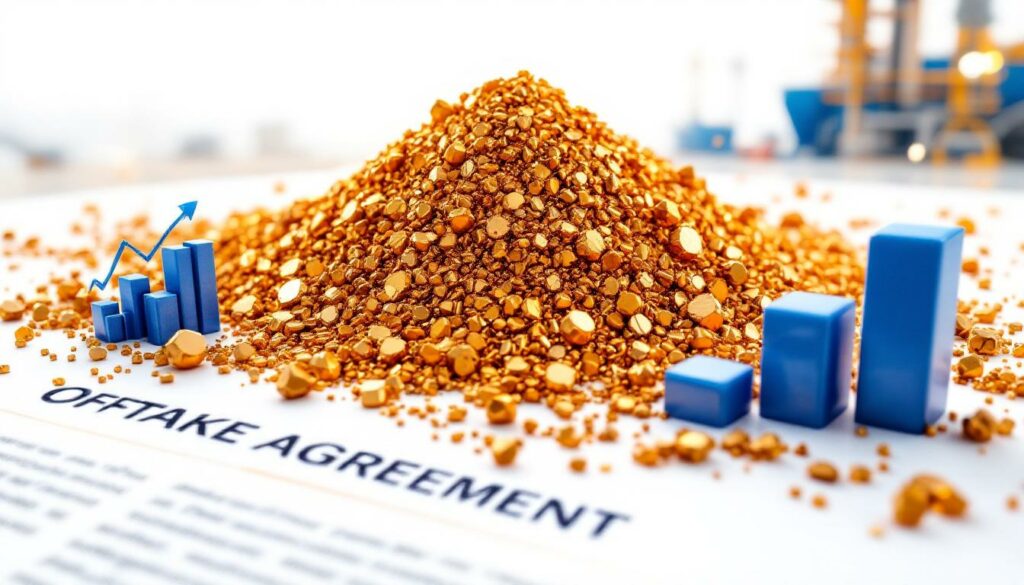What is an Offtake Agreement in Mining? Understanding Strategic Mineral Supply Contracts
An offtake agreement in the mining industry represents a crucial contractual arrangement between mining companies and buyers that establishes long-term purchase commitments for future mineral production. These strategic partnerships provide financial stability and market assurance for both parties in what is typically a volatile minerals marketplace.
Fundamentally, offtake agreements function as risk management tools that create a win-win scenario: mining companies secure guaranteed revenue streams while buyers ensure consistent access to critical mineral supplies. This mutual benefit explains why offtake agreements have become foundational components in resource project development.
For mining projects—particularly those in development stages—these agreements serve as powerful validation mechanisms that can significantly influence financing decisions, operational planning, and overall project viability.
How Do Offtake Agreements Benefit Mining Projects?
Securing Project Financing
Offtake agreements function as powerful catalysts for securing project financing, particularly benefiting junior mining companies with limited balance sheet capacity. By demonstrating guaranteed future revenue streams, these contracts significantly enhance a project's bankability and investor appeal.
"The presence of a credible offtake partner can often be the difference between a project proceeding or stalling," notes industry experts who regularly advise on mining finance structures. "Lenders view these agreements as critical risk mitigants that transform speculative future cash flows into more predictable revenue streams."
For projects seeking debt financing, offtake agreements typically satisfy a fundamental prerequisite that many lenders require before committing capital. The agreements effectively reduce revenue uncertainty—a primary concern for debt providers—by establishing minimum purchase volumes at predetermined pricing mechanisms. These arrangements are increasingly important in strategic financing in mining deals across the resource sector.
Reducing Market Risk
These agreements effectively shield mining operations from market volatility through several key mechanisms:
- Price floor provisions that establish minimum pricing even during market downturns
- Volume commitments that ensure consistent production offtake regardless of market conditions
- Take-or-pay clauses that require buyers to pay for minimum quantities even if they cannot accept delivery
- Long-term duration spanning multiple years to bridge market cycles
This market risk protection allows mining companies to focus on operational excellence and production optimization rather than constantly reacting to short-term market fluctuations. It creates a more stable foundation for business planning and corporate strategy.
Facilitating Project Development
For projects in development stages, offtake agreements can dramatically accelerate timelines by providing the financial certainty needed to proceed with construction and operational planning. They often serve as critical prerequisites for securing comprehensive debt financing packages.
"Offtake agreements function as cornerstone documents that unlock the entire project financing structure," explains mining finance specialists. "They transform geological potential into commercial reality."
The agreements also provide valuable technical validation when sophisticated buyers conduct extensive due diligence on product specifications and quality parameters. This third-party validation often strengthens investor confidence in the project's technical fundamentals. Understanding the mineral exploration importance is fundamental to appreciating why buyers enter these long-term commitments.
What Key Terms Are Included in Mining Offtake Agreements?
Product Specifications and Quality Requirements
Offtake agreements meticulously define the concentrate or mineral product specifications, including detailed parameters such as:
- Minimum metal content percentages (e.g., copper >24%, gold >50 g/t)
- Maximum allowable impurities (e.g., arsenic <0.2%, mercury <10 ppm)
- Physical characteristics requirements (e.g., moisture content <8%, particle size distribution)
- Testing and sampling procedures (including reference laboratories and dispute resolution mechanisms)
These specifications reflect both the capabilities of the mining operation and the technical requirements of the buyer's processing facilities. Extensive metallurgical testing typically precedes final agreement on these parameters to ensure mutual compatibility.
Pricing Mechanisms and Payment Terms
These agreements establish clear financial frameworks through several interrelated components:
- Reference price benchmarks tied to transparent market indices (LME, COMEX, LBMA)
- Premium/discount structures based on quality variations from baseline specifications
- Payment timing provisions (typically 90-95% provisional payment upon delivery with final settlement after assays)
- Currency specifications and potential hedging provisions
- Price floor/ceiling mechanisms in some cases to mitigate extreme market movements
The pricing structure must balance fairness between parties while providing sufficient transparency and objective reference points for dispute avoidance. These mechanisms often incorporate current gold price analysis and other metal pricing trends.
Volume Commitments and Delivery Schedules
Contracts typically specify detailed volume and logistics parameters:
- Annual or quarterly volume requirements (often with minimum and maximum ranges)
- Flexibility provisions for production variations (typically ±10-15%)
- Delivery location specifications and transfer of title/risk provisions
- Logistics responsibilities (transportation, insurance, customs documentation)
- Consequences for delivery shortfalls (financial penalties, make-up provisions)
These terms must align realistically with the mine's production capabilities while providing sufficient certainty for the buyer's operational planning.
Treatment and Refining Charges
For concentrate products, agreements include detailed processing cost allocations:
- Treatment charges (TC) for concentrate processing (typically per dry metric tonne)
- Refining charges (RC) for extracting and refining contained metals (typically per pound or ounce)
- Penalty structures for deleterious elements exceeding threshold levels
- Recovery assumptions for contained metals during processing
- Payability percentages for various metals (typically 95-97% for base metals, 90-95% for precious metals)
These charges reflect both market conditions and the specific characteristics of the concentrate, with higher-quality products generally commanding more favorable terms.
How Does the Troilus Gold-Boliden Agreement Exemplify Modern Offtake Structures?
Project Production Profile and Concentrate Quality
The Troilus project represents a significant copper-gold operation with robust production metrics:
- 135.4 million pounds of copper equivalent annual production
- 75,000 wet metric tonnes of concentrate yearly
- Multiple payable metals including copper, gold, and silver
- High-quality concentrate meeting European smelter specifications
Metallurgical testing and historical performance data confirm the concentrate will meet required specifications without incurring penalties for deleterious elements. This quality assurance was a key factor in securing favorable commercial terms with Boliden.
As Troilus Gold CEO Justin Reid emphasized: "We are pleased to align with key players in Europe's critical minerals ecosystem and believe these recent offtake agreements reinforce our technical credibility and the high quality of the product we intend to deliver."
Strategic Partnership Advantages
The agreement between Troilus Gold and Boliden demonstrates several strategic benefits:
- Renewal of historical relationships from previous mining operations
- Integration into European critical minerals supply chains
- Alignment with responsible sourcing principles and sustainability objectives
- Complementary relationship with another offtake partner (Aurubis)
This multi-partner approach provides Troilus with diversification benefits while still maintaining sufficient volume commitments to each smelter for establishing meaningful long-term relationships. Such arrangements are increasingly important in national critical minerals strategy implementation.
As Reid noted, "We are proud to welcome one of Europe's most respected mining and smelting companies as an offtake partner, renewing a long-standing relationship that began during Troilus' past-producing years, when Boliden processed some of the site's original concentrate."
Financial Structure Integration
The offtake agreement forms part of a comprehensive financial strategy including:
- Coordination with a $700 million debt financing package
- Support from export credit agencies enhancing financing terms
- Involvement of specialized metals trading advisors (Auramet and Ocean Partners)
- Timing alignment with construction decision milestones
The integrated approach demonstrates the interconnected nature of modern project development, where commercial, financial, and technical workstreams advance in parallel toward construction decisions.
The final binding offtake agreements are anticipated to coincide with the completion of the comprehensive debt financing package announced in March 2025, which is being organized by Société Générale, KfW IPEX-Bank, and Export Development Canada.
What Trends Are Shaping Modern Mining Offtake Agreements?
ESG Considerations and Responsible Sourcing
Modern offtake agreements increasingly incorporate sustainability dimensions:
- Environmental performance requirements and carbon footprint considerations
- Social responsibility commitments regarding labor practices and community relations
- Supply chain transparency provisions for downstream reporting
- Alignment with international standards and certification requirements
These ESG elements reflect growing downstream pressure from consumers, regulators, and investors for responsible sourcing throughout mineral supply chains. Smelters and refiners increasingly evaluate mines not only on product quality but also on sustainability credentials.
Geopolitical Factors and Supply Chain Security
The strategic importance of mineral supply chains has elevated several geopolitical considerations:
- Regional partnership preferences based on national security interests
- Critical mineral designations influencing government support mechanisms
- Domestic processing incentives to reduce import dependencies
- Geopolitical risk mitigation strategies across diversified supply networks
The Troilus-Boliden agreement exemplifies this trend through its alignment with European critical minerals strategies that seek to secure stable supply relationships with trusted jurisdictions like Canada. This trend is also evident in emerging copper-uranium investments across stable mining jurisdictions.
Technological Adaptations and Quality Specifications
Evolving end-use technologies are driving changes in concentrate requirements:
- More stringent purity requirements for high-tech applications
- New specifications for emerging applications in renewable energy and electrification
- Advanced testing and verification methods for quality assurance
- Specialized product streams for specific industries and applications
These technological demands require closer collaboration between miners and processors to ensure products meet increasingly specialized requirements for downstream applications.
How Do Companies Evaluate Potential Offtake Partners?
Smelter Compatibility Assessment
Mining companies must carefully evaluate technical compatibility factors:
- Technical compatibility with smelter processes and feed requirements
- Historical performance with similar concentrates and demonstrated expertise
- Capacity availability and processing priorities within smelter networks
- Geographic logistics considerations and transportation costs
This technical assessment ensures the concentrate will integrate smoothly into the smelter's operations without unexpected processing challenges or quality disputes.
Financial Stability and Commercial Terms
Critical evaluation factors include:
- Partner creditworthiness and financial strength to ensure payment reliability
- Competitive pricing structures and benchmarks relative to market alternatives
- Payment terms and working capital implications for cash flow management
- Track record of contract fulfillment and commercial relationship management
For development-stage companies like Troilus Gold, the financial credibility of offtake partners plays a crucial role in supporting broader project financing efforts.
Strategic Alignment and Relationship Potential
Beyond transactional considerations, companies assess longer-term strategic factors:
- Long-term strategic fit and growth alignment between companies
- Potential for expanded business relationships beyond initial offtake
- Shared values regarding sustainability and ethics in mining and processing
- Flexibility and problem-solving approaches during operational challenges
These relational elements often determine whether offtake relationships remain successful through inevitable market cycles and operational challenges.
What Are the Legal Considerations in Offtake Agreements?
Force Majeure and Material Adverse Change Provisions
Contracts must address potential disruptions through detailed contingency provisions:
- Clearly defined force majeure events (natural disasters, labor strikes, regulatory changes)
- Notification and mitigation procedures when events occur
- Duration limitations and termination rights for prolonged disruptions
- Alternative performance options when primary obligations become impossible
These provisions balance protection against genuine impossibility while preventing opportunistic contract evasion during challenging market conditions.
Dispute Resolution Mechanisms
Effective agreements establish clear conflict resolution frameworks:
- Governing law and jurisdiction specifications appropriate to both parties
- Structured escalation procedures from operational to executive levels
- Arbitration or mediation preferences for formal disputes
- Expert determination processes for technical disagreements
These mechanisms recognize that long-term relationships inevitably encounter disagreements and provide efficient pathways to resolution without relationship breakdown.
Compliance and Regulatory Requirements
Modern agreements must navigate complex compliance landscapes:
- Anti-corruption and sanctions compliance obligations for both parties
- Environmental and social governance standards alignment
- Changing import/export regulations affecting cross-border transactions
- Tax and royalty implications for various jurisdictions
These compliance considerations have grown increasingly complex as regulatory frameworks evolve and enforcement intensifies globally.
FAQ: Common Questions About Mining Offtake Agreements
How long do typical mining offtake agreements last?
Most mining offtake agreements span 3-10 years, though some strategic partnerships may extend to life-of-mine arrangements. Initial terms often align with debt financing repayment schedules, with options for renewal or renegotiation at predetermined intervals.
The duration typically balances the mining company's desire for long-term certainty with the buyer's preference for flexibility as market conditions evolve. Projects with significant capital requirements generally secure longer terms to support initial financing requirements.
Can offtake agreements be transferred if a mining project changes ownership?
While offtake agreements typically include change-of-control provisions, transfers generally require consent from the offtake partner. The specific terms vary widely based on the strategic importance of the relationship and market conditions at signing.
Key factors influencing transferability include:
- The financial strength of the proposed new owner
- Technical capabilities to maintain product specifications
- Continuing alignment with strategic objectives
- Compliance with applicable regulatory requirements
Consent for transfer is typically not unreasonably withheld when the fundamental business case remains intact.
How do offtake agreements handle production shortfalls or quality issues?
Most agreements include detailed provisions for production shortfalls, including:
- Minimum fulfillment requirements (typically 80-90% of contracted volumes)
- Make-up delivery options in subsequent periods to remedy shortfalls
- Financial compensation mechanisms when physical delivery isn't possible
- Termination rights for persistent failures beyond specified thresholds
For quality issues, agreements typically specify:
- Detailed testing protocols with referee laboratories
- Rejection thresholds for severe quality deviations
- Price adjustment formulas for minor quality variations
- Collaborative problem-solving procedures for systemic issues
These provisions recognize the operational realities of mining while maintaining appropriate accountability.
What role do offtake agreements play in project financing?
Offtake agreements serve as cornerstone documents in project financing packages by:
- Demonstrating revenue certainty to lenders through guaranteed sales
- Providing collateral for loans through assignment of proceeds
- Establishing market validation of product quality and specifications
- Creating financial predictability for debt service coverage modeling
For the Troilus project, the offtake agreements with Boliden and Aurubis represent critical components of the $700 million debt financing package being assembled with support from international financial institutions and export credit agencies.
Further Exploration:
Readers interested in learning more about mining offtake agreements and strategic mineral supply contracts can also explore related educational content at Mining Technology's website, which offers additional perspectives on mining industry developments and commercial structures.
The Troilus Gold-Boliden agreement represents a compelling case study in how modern offtake agreements integrate commercial, financial, and sustainability objectives to advance significant mining projects toward development.
Want to Discover the Next Mineral Boom Stock Before the Market?
Discover significant ASX mineral discoveries the moment they're announced with Discovery Alert's proprietary Discovery IQ model, transforming complex mineral data into actionable investment insights. Explore why historic discoveries can generate substantial returns by visiting Discovery Alert's dedicated discoveries page and begin your 30-day free trial today.




